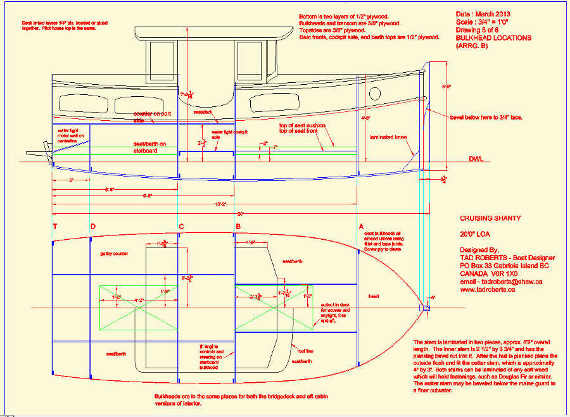Cruising Shanty 20, 20' Shanty Boat
 20’ Cruising Shanty 20, version A
20’ Cruising Shanty 20, version A  20’ Cruising Shanty 20, version A
20’ Cruising Shanty 20, version A  20’ Cruising Shanty 20, version A
20’ Cruising Shanty 20, version A  20’ Cruising Shanty 20, version A
20’ Cruising Shanty 20, version A  20’ Shanty Boat, version B
20’ Shanty Boat, version B  20’ Shanty Boat, version B
20’ Shanty Boat, version B  20’ Shanty Boat, version B
20’ Shanty Boat, version B  20’ Shanty Boat, version A
20’ Shanty Boat, version A
Similar Designs
About the Plans
Construction Method and Materials:
Plywood on frames. Construction is simple, the lower hull is built upside down, sheathed with fabric set in epoxy, and turned over for completion of the upperworks. The lower hull is double layers of ¼” plywood, with seams overlapping, while the topsides are single layers.Number and Type of Drawings:
All CAD PDF files. Nine sheets. Both versions on the same plan set.- 1. Bulkhead locations version A
- 2. Hull parts both versions
- 3. Bulkheads version A (sections)
- 4. Bulkheads version B (sections)
- 5. Bulkhead locations version B
- 6. Deck and house parts version A
- 7. Topsides, deck and house parts version B
- 8. Misc. details (boottop, mpotor, windows)
- 9. Construction description, stem and skylight detail
Design Comments

To be successful a Shanty boat must be simple and cheap (relatively) to build. A 20’ Shanty that costs $75,000 (Harry Bryan) dollars is an expensive mistake. For that kind of money today one can buy an ocean cruiser and really get lost. The real shanty will consume less than a quarter of those dollars including a used outboard. Capabilities are of course limited to coastwise and protected water cruising.
That is another thing. If you build a boat that looks like it might be a houseboat, someone will object. But if you build a houseboat (which a single person might liveaboard full time) that looks like a boat, you may fall below the radar. Thus my little Shanties have some shape in their sides and a stem so they look like boats. Some space is lost for a gain in aesthetic appeal which may get you a coveted inside berth at the marina.
Construction is simple, the lower hull is built upside down, sheathed with fabric set in epoxy, and turned over for completion of the upperworks. The lower hull is double layers of ¼” plywood, with seams overlapping, while the topsides are single layers.
Both arrangements will sleep 3-4 people with room left over. Both boats have a complete galley and small head with composting toilet. Solar panels, a windmill, rain catchment, and a wood stove all equal independence. In a tiny package it is possible for small dollars.
The style of the Shanty 20 and the Marjorie 26 is reminiscent of this cruiser designed and built by my grandfather Harry Roberts, shown here in 1912 near Roberts Creek, BC.
